Salmon Fishing: The Most Comprehensive Guide

We’re taking the mystery out of fishing for salmon by covering everything about catching salmon, and I will reveal our guide tactics, favorite baits, best setups, best lures, and also tell you what gear we recommend to our clients.
Fishing for salmon and actually catching salmon consistently means anglers need to understand the salmons feeding habits, ideal water temps, their run times, holding spots, and what baits and lures trigger them to bite.
One of the tips I tell my clients is, “if you don’t fish like salmon guides, you will struggle to catch salmon.”
The Sport Of Salmon Fishing

Fishing for salmon is a popular sport for many anglers, especially in summer when salmon are out in the ocean and in the fall when the salmon enter the rivers to spawn.
When salmon run the rivers, anglers have the chance to hook into many large salmon in a day since the salmon will come into the rivers by the thousands, concentrate in pools, and run throughout the river.
There are many salmon species anglers can fish for.
Fishing For Chinook Salmon

The chinook salmon is a North American West Coast species of salmon found in the Pacific Ocean and its tributaries. Anglers also call them king salmon, or kings, springs, or chinnies.
You can catch Kings as far south as Monterey Bay in California and as far north as the Chukchi Sea in northern Alaska.
There is also a large population of chinook salmon in the Great Lakes areas, which were stocked there to create a new fishery for anglers.
The average fall chinook salmon is around 36 inches long and weighs about 30 pounds. In amazing conditions, they can grow to 4.9 feet in length and weigh up to 126 pounds.
Spawning times are dependent upon location. NOAA says they spawn from October through December, but on the Kenai Peninsula in Alaska, the spawning grounds are often full by June or July.
Around the Great Lakes Region, small sporadic runs will enter some rivers after rains in July and August, but normally, all salmon rivers will see the biggest runs of salmon from mid-September to late October.
Peak times for king fishing would be in October, and the top destinations are bigger rivers like the Niagara River, Salmon River in NY, West Michigan rivers like the Manistee River, and the Credit River, Ontario Canada.
Fishing For Coho Salmon Fishing
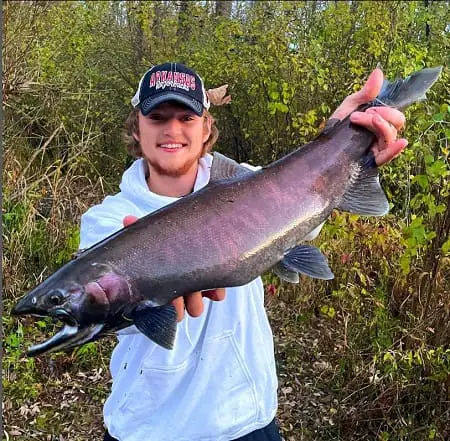
The Coho, which is also known as silver salmon, or silvers, are West Coast Pacific salmon.
Silver salmon range from the central coast of California to the Arctic Circle in Alaska as well as the Great Lakes region. Around the Great Lakes, some rivers will have very good runs of Coho salmon.
Coho salmon have an average length of 24 inches and a weight of 8-12 pounds. The world record for coho salmon from the Salmon River in New York is 33.4 pounds and is 42.5 inches long. Caught on September 27, 1989. See Fishing For Salmon On The Salmon River in NY.
Silver salmon spawning grounds become active as early as August in the far Pacific north and later in the year in lower latitudes. In California, the Coho run from November all the way through January.
In Alaska on the Alaska Peninsula, silver salmon begin entering the rivers and spawning as early as June and July, and by late July, the rivers are full.
See Fishing For Salmon In Alaska: A Complete Guide For More Salmon.
Around the Great Lakes, anglers will start coho fishing the rivers in late September through to November.
Sockeye Fishing

Sockeye salmon, also commonly referred to as red salmon or reds, is a Pacific Salmon. You can find sockeye salmon as far north as Point Hope, Alaska, and as far south as the Sacramento River in California.
Sockeye Salmon are smaller fish compared to Silver and King salmon. An average sockeye is 4-5 pounds, but they can reach 15 pounds. Generally, Sockeye salmon stay in the 1.5-foot length range but can grow to 2.5 feet.

Generally, early to mid-summer is a prime time to catch sockeye in the rivers, especially in northern BC and Alaska. Sockeye are not aggressive strikers and won’t hit lures or baits, or most flies since they feed on plankton and smaller critters.
The top destination for Sockey fishing is the Kenia River in Alaska, where large numbers enter the river all at once.
Pink Salmon

Pink salmon are primarily cold-water Pacific salmon that are unique from other Pacific salmon species.
Unlike other salmon that run up the rivers every year, pink salmon only spawn every other year, and in many places, they run only on odd-numbered years.
Their size also makes them unique since mature pinks are usually under 5 pounds.
You will find pink salmon in the Bering Sea and all along the shores of Alaska, through the gulf, and down to the calmer waters of Washington state. Puget Sound is a haven for pink salmon.
You will find small numbers of pink salmon in many of the Great Lakes and their tributaries.
The world record for pink salmon is 15 pounds. Generally, you will find them in the 3-5 pound range.
The run times for pinks are August-October, but that will vary based on location. In colder areas such as Anchorage Alaska, they will run early. In warmer waters, they will run later.
They are voracious over salmon roe and egg-type imitations. See all about fishing Pink Salmon.
Chum Salmon

Chum salmon range from Yaquina, Oregon, all the way through most of Alaska to the Arctic coast of Canada.
This is one species of Pacific Salmon that is not stocked in the Great Lake or other locations.
The average weight of chum salmon is 8-15 pounds, but the world record for chum salmon is 42 pounds. The spawning runs begin in mid-to-late summer and can run all the way through March.
Chum salmon will also hit flies, baits, and lures. Almost any pattern fly will do, but egg patterns and leaches are popular options.
Atlantic Salmon
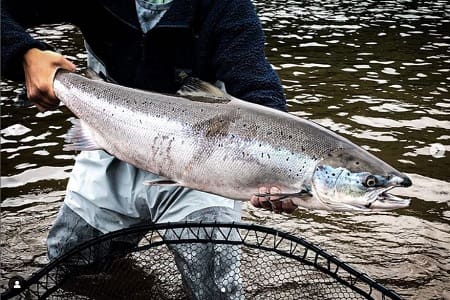
The Eastern North American Atlantic salmon range from Greenland down to the Long Island Sound and up into Northern Quebec, Canada. Northern Quebec is said to have some of the world’s best Atlantic Salmon rivers for fishing. Labrador is also a top destination for Atlantics.
Atlantics were re-introduced to the Great Lakes in 1972 when stocking programs began in Lake Michigan, and top rivers include the Ausable, St. Mary’s River, and the Salmon River in NY.
An average Atlantic salmon weighs between 8-12 pounds and can grow as long as 30 inches.
The world record for Atlantic salmon is 109 pounds from Scotland. The record for Lake Michigan is 32.62 pounds.
Depending on the area, Eastern and Northern rivers will see Atlantic salmon entering rivers as early as June and July. Spawning begins in early fall and is generally done by December.
The best run times will vary, but October is a peak month in many locations for Atlantic salmon.
Fly fishing is popular for Atlantics, as is spin casting. Lure, bait, and flies are three options. Techniques include drifting bait and fly fishing.
If you are looking to do a trip of a lifetime for salmon, don’t forget to check out the article Best Salmon Destinations in The USA.
Fishing Tackle For Salmon

The fishing tackle used will depend on which salmon species you are fishing for. Larger salmon require larger and longer rods, reels, lines, leaders, and hooks.
Smaller pinks and sockeye require lighter gear.
The setup for catching salmon is not complex. You will need:
Salmon Rods
Regarding rods, I prefer a longer rod to help improve casting distance and for fighting the fish, and a better presentation.
- Float Fishing Rod: 12 to 14 feet long with a line rating of 8 to 20lb. A longer rod acts like a shock absorber, which protects lighter leaders and aids in keeping the mainline off the water, giving you a better presentation.
- Fly rod: Streamer Rod 9 foot 9 weight, Nymphing Rod – 10 foot 8 or 9 weight, Spey Rod – 12 to 14 foot 8 or 9 weight.
- Spinning Rod: 7.5 t0 10 feet long, with a line rating of 15 -30 pounds test is an average salmon rod. If you are targeting bigger fish, a long rod with a line rating of upwards of 25-30 pound test is ideal. Medium action is ideal for pinks, sockeye, and most coho salmon. Medium-heavy action for bigger fish, including chinook and Atlantic salmon. See my article on the 11 Best Rods For Salmon In Rivers.
Salmon Reels
Spinning Reel: Again, the spinning reel size will need to match the size of the salmon. A reel for king salmon would be a size 3500, or for big rivers, a 4,000 series spinning reel will work.
A 2500 or 3,000 series would be ideal for pink salmon or coho and chum.
Baitcaster reels: Levelwind reels are used for many methods, especially when trolling. See Best Baitcasting Reels For Salmon.
Fly Reels: Larger arbor fly reels in sizes 7 to 9 weight work well for catching salmon. Spey reels.
For smaller fish, go with the 6/7/8 weight reel, and for larger salmon, go with the 7/8/9 weight reels.
Line For Salmon
Braided line is pretty much the standard with a mono or fluorocarbon leader. Braided line in the 15-30 pound test will work well for most salmon.
Leaders For Salmon
Most anglers will use a Fluorocarbon leader between 12 and 16 pounds in the Great Lakes, and 30 to 40 pounds in the West Coast area. Your leader size will depend on the size of the salmon and the type of method you want to use. I’ll discuss the different methods below.
Weights, Hooks, and Terminal Tackle
Split shot weights are used a lot when bait fishing. For some methods like drift fishing and plunking, anglers will use pencil lead or bell sinkers. I will show you leader setups and best weights for each of these methods.
Other potential terminal tackle will include swivels, snap swivels, bobber stops, and three-way swivels.
Hooks: The best salmon hooks for bait fishing and for your flies are wide gap, and extra thick, and extra strong. in sizes two aught to size six.
Other Salmon Gear Includes:
- Landing net suitable for large salmon – see the best nets for salmon article.
- Waders and boots – Good waders and boots get you into better positions and help you cross the rivers safely.
- Rain Gear – Rain gear or a good waterproof wading jacket is advisable for fall, winter, and spring fishing.
- Polarized sunglasses are a must for spot fishing and fighting glare.
- Packs or Vests – A water-resistant chest or lumbar pack or a fishing vest is very handy for keeping all your flies, baits, and release gear handy.
Check out my article River Fishing Gear: Everything You Need To Succeed In 2023
How To Catch Salmon

Salmon are a saltwater and freshwater species, so anglers target them in the ocean, the mouth of rivers, and in rivers.
Spin fishing, baitcasting, boat fishing methods, and fly fishing are used.
Most ocean fishing is with trolling gear or jigging methods, but bank and shore anglers are catching plenty of salmon too.
I’ll discuss all the best methods for open water and river fishing below.
Great Lakes Region Salmon

The Great Lakes can be some of the best fishing in the world for chinook salmon. The deal is that you have to know where to find the salmon.
Fishing in the lakes is usually by charter or boat, and the method is trolling.
Fishing nearshore can be by boat or from shore with fly rods, spey rods, or spinning rods – drifting, plunking, and float fishing are popular methods.
From boats, the deeper waters in the summer are often where you find salmon in the 40-60F water zone.
From shore, usually in the late summer and early fall, you can fish near the mouth of rivers. Shore fishing, pier fishing, and boat fishing are all viable methods of putting you where the salmon are.
If you are fishing in this area, be sure to read How To Fish For Great Lakes Salmon in Rivers: Guide Tactics.
Where Is The Best Place For Catching Salmon Around The Great Lakes

Three of the best salmon-fishing Great Lakes to salmon fish include Ontario, Huron, and Lake Michigan.
Lake Superior also holds chinook, coho, Atlantic, and pink salmon.
Lake Michigan Salmon- The mouth of the Milwaukee River, its tributaries, and offshore is a hot spot.
The Pere Marquette, Manistee River, Muskegon River, and St Joseph River, as well as all Lake Michigan salmon rivers are worth fishing.
The largest rivers generally get the largest runs of salmon, and by mid-October, they should be full of salmon. If your goal is to fish on Lake Michigan, check out Lake Michigan Fishing: 3 Top Guides Tell You How And Where.

Lake Huron – The Spanish River and its channel are both hot spots for late summer and fall salmon. The St Mary’s River and St. Mary’s Rapids also has the best fishing for Altlantics, and good fishing for Cohos, Kings, Pink salmon, and steelhead.
Lake Superior – Flag and Cranberry Rivers are two spots where catching big salmon is good. The mouth of the rivers and near-shore fishing, otherwise you can troll the deeper water in warm weather.
Lake Ontario – Just about any tributary flowing into Lake Ontario will get some salmon. Larger rivers like the Oswego River NY, The Salmon River NY, The Niagara River, The Credit River ON, and the Ganaraska River all get runs of salmon. By mid-October, most Ontario rivers will have the maximum amount of salmon in them.
Lake Erie – Lake Erie does not have fishable numbers of salmon.
West Coast Salmon
You can fish for Pacific salmon from California to the Alaska peninsula. Saltwater salmon fisheries around Anchorage, Skeena, Vancouver, and most rivers south to Washington will get runs of salmon to some extent.
The bigger the river and the more miles to the spawning grounds the earlier the migration will start with northern area migrations starting in June.
Where Is The Best Salmon Fishing In The West?
The best place? That will depend on the time of year. Generally, the warmer the weather, the later the runs.

Alaska Salmon- It is difficult to beat the Kenai Peninsula whenit comes to fishing for huge salmon in June and July.
The runs of sockeye are in the millions, and the runs of king salmon and coho salmon are in the hundreds of thousands.
The Kenai River, Russian River, and Kasilof River are three of the best freshwater salmon destinations available. Anchorage is a good starting point, and you are sure to find charters and accommodations near Anchorage.
Cook Inlet, the waters off Homer, and Resurrection Bay are three of the best areas for salmon trips. There are plenty of fishing opportunities near Anchorage Alaska.
BC Salmon – British Columbia is one of the best salmon destinations in the world, with fantastic Ocean fishing and fantastic rivers. You will find plenty of lodges and charter boats near these prime destinations. On larger rivers, you may find big salmon starting their migration early in June to get to the best spawning areas far up the river.
Best BC Ocean Fishing:
- Chatham Sound
- Clayoquot Sound
- Comox Harbour
- Haida Gwaii/Langara Island
- Milbanke Sound
- Nootka Island
- Port Hardy
- Quatsino Sound
- Rivers Inlet
- Tofino
- Ucluelet
Best BC Rivers:
- Campbell River
- Chilliwack/Vedder Rivers
- Cowichan River – Coho Salmon
- Dean River
- Kitimat River
- Powell River
- Skeena River
- Stamp River
- Fraser River
There is also some great salmon opportunities farther south in Washington and Oregon in the Columbia River system.
In Oregon, check out:
- Salmon River
- Rogue River
- Tillamook Bay
- Trask River
- Wilson River
- Nestucca River
- Siletz River
- Siuslaw River
- Alsea River
East Coast Salmon
For Atlantic Salmon, it is difficult to beat The Penobscot River in Main – The western branch; however, good luck getting a spot to fish there.
- Morell River and Mill River in PEI
- Gander River NL
- Humber River
- Exploits River
- Grey River
- Portland Creek
- Pinware River
- Flowers River
If you are going to fish any of these areas or rivers, be sure to check the regulations before you fish.
Boat Fishing For Salmon
The use of boats out in the open water is a great way of catching salmon.
Ocean Fishing Methods For Salmon

The most popular and effective method for fishing salmon from a boat is trolling, and this is what guides and charter services do.
Find schools of herring and troll around them looking for feeding salmon.
People are fly fishing for coho salmon in saltwater in select areas where the coho stack up. Beach fishing is a good option.
Charters work best in saltwater unless you have a boat big enough to handle the ocean swells.
Normal methods of trolling include flat lining, which means you just let your line straight out the back of the boat while you troll.

You can also use Dipsy Divers, which are inline devices that pull your lures down to a desired depth based on how much line you let out. This method is great if the fish are 10 to 60 feet down.
Downriggers are most often used on charter boats because the guide or captain can get exact depths with their lures by lowering the downrigger balls (weights).
I use cut-baits with herring, trolling spoons, crankbaits, and at times plugs, when trolling.
Morning fishing and early evening are good times to be on the open water since the water is calmer and the salmon are more active. Some of the largest salmon are caught in low-light conditions.
Mooching For Salmon: Mooching for salmon is a boat method used for chinook and coho salmon. When mooching, you drop a bait over the side of the boat to the level the salmon are feeding, and then reel up, and then drop again. It can be very exciting and effective if done well and if you use the right bait.
Ocean rules and regulations and catch limits may apply to your state or province.
Lake Fishing Methods For Salmon
Generally, you troll for salmon on the Great Lakes similar to how you troll on the ocean. You can also fish from the shore, which I will discuss below.
On big lakes, charter boats are your best bet unless you have a good-sized boat and all the required gear.
The key is to know where in the lake the salmon are, and then target them based on water temperature.
Early in April, the salmon will often be in closer to shore. In the summer, the salmon can be over 20 miles out feeding on schools of bait.

A fish finder will help, especially if it shows water temperature and depth.
Locate big schools of bait, and you are surely going to find some big salmon.
Understanding their migration patterns also helps.
Shore Fishing

Shore fishing includes fishing from piers, around the mouth of rivers, and shorelines or beaches.
The best times will vary by season. The best fishing is when the salmon are preparing to enter the freshwater to spawn and are staging near shore.
I will also cast lures such as spoons, spinners, crankbaits, and plugs.
When shore fishing, I will either cast a bait using what is known as the “plunking method” or I will use a slip bobber that will allow me to fish 10 to 30 feet deep.
Jigs can be fantastic since they will cast far and get to the bottom where sometimes the salmon are cruising.
Incoming tides or strong winds blowing into the shores will often be the best times to fish near shore since currents will bring in baitfish and salmon closer to the shores.
River Mouths And Pier Fishing

Fishing a river mouth is one of the best ways to target a lot of salmon. This could mean casting into the river or casting out into the open water into or along side the current flow.
Often, March and April will see salmon in closer to shore and in proximity to allow the salmon anglers to cast to them.
Late July and August will also see salmon moving in closer to shore, especially near the spawning rivers.
Salmon might start showing up near river mouths 30 days prior to the spawn and just hang around until the river conditions are suitable for them to start tithe migration.
I have found that the key to river mouth fishing is fishing during low light, which means fishing early mornings and at dusk, which is when most salmon will move in closer to the river mouth or even up into the river. Cloudy days are also a good time to fish.
Methods For River Fishing For Salmon

The general methods of fishing salmon in rivers are either fly fishing or using a spinning rod and reel setup with a bobber or a drift fishing method, or with lures.
In some situations, you would use a Spey rod, which will enable you to cast across the river at longer distances on wider and shallow rivers where fly presentation is essential.
I go into great detail on the best methods and baits that I use to get my clients into more salmon once they enter the river, all on my page, How To Catch Salmon In A River: Guides Explain Methods And More…
Fly Fishing Methods
There are three common methods of fly fishing for migratory salmon to consider, and all three work well if you know how to use them, when to use them, and when you use the right flies.
Spey Fishing For River Salmon
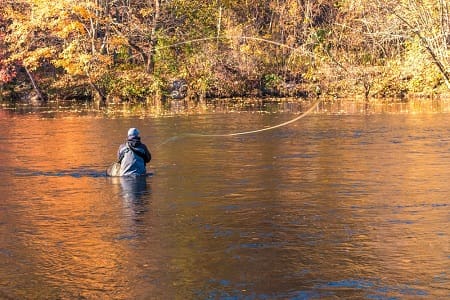
With Spey fishing, anglers and guides use a two-handed Spey rod between 11 and 14 feet long and a heavy fly line.
With what is known as the Spey cast, the angler can make very long casts across the river with little to no back cast.
With the use of sinking leaders or lines, the goal is to swing the large spey fly across the river in front of the salmon and wait for a bite.
Check out Spey Fishing For Steelhead & Salmon: Best Setup And Tactics.
I discuss over 40 of the most effective flies, including nymphs, Spey flies, dry flies, streamers, and tube flies for all the salmon species in my article, Best Flies For Salmon.
Nymphing For Salmon
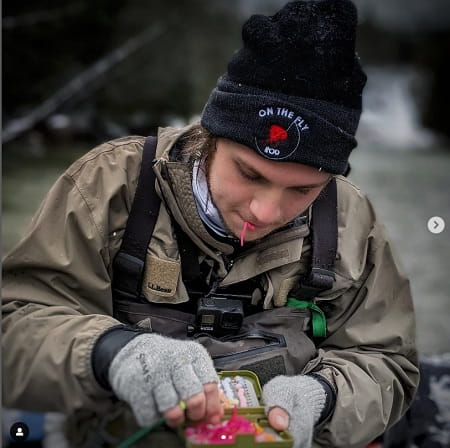
Nymphing is a popular fly fishing method that I use to drift flies below the surface, and this method works well in smaller streams or when the salmon are held up in pools.
These flies are often called nymphs and they resemble aquatic insects, but I also use egg patterns, which are often one of the best fly patterns for salmon.
There are two primary nymphing techniques all salmon fly anglers should know, which are Indicator fishing and Euro Nymping.
Indicator fishing is likely the most popular nymphing method, and it involves using a brightly colored float or bobber known as a strike indicator, which is meant to indicate when a strike occurs.

Skilled indicator anglers also use their indicators to control the speed of the fly, which is one of the most critical things required if you want to catch a lot more fish.
I go into more detail on nymph fishing on my page Nymphing For Salmon: How The Guides Do it.
Euro Nymphing For Salmon

Euro nymphing for salmon is a relatively new method. It can be very effective in certain situations.
Euro Nymphing is a short-line and tight-line nymphing method that uses a piece of colored mono mid-way up the leader, which helps indicate a strike. You use 1 or 2 weighted flies and no split shot on the line, and you try to maintain light tension on the leader as the fly drifts down the river.
The colored piece of line is called a “Sighter,” and it enables the angler to detect a strike, control the speed of the fly, as well as control the depth of the fly. All these factors can lead to more fish.
Euro Nymphing is a method I use in shallow water under 6 feet, in pocket water, and in smaller holes where close fishing is required.
Streamer Fishing

A streamer is a type of wet fly that usually resembles a baitfish. When streamer fishing salmon, you simply cast your streamer fly out and use a line stripping-in type of retrieve that imparts a swimming-type action to the streamer fly.
Also, for more details on all the best fly fishing methods, best flies, and required fly gear, check out Fly Fishing Salmon: Tactics Used By Guides For More Salmon.
Float Fishing

Float fishing is a method using a float, also called a bobber to suspend and drift your bait down the river with the current.
Having your bait suspended just off the bottom in pools, riffles, or rapids will keep your bait in the strike zone longer and will equal more salmon hooked.
In many rivers, float fishing is the most effective method for catching salmon.
There are four fundamentals to float fishing effectively, and I discuss this on my page Float Fishing Salmon – Great Lakes Tactics From A Top Guide. If you are not doing each of these fundamentals well, you are missing fish.
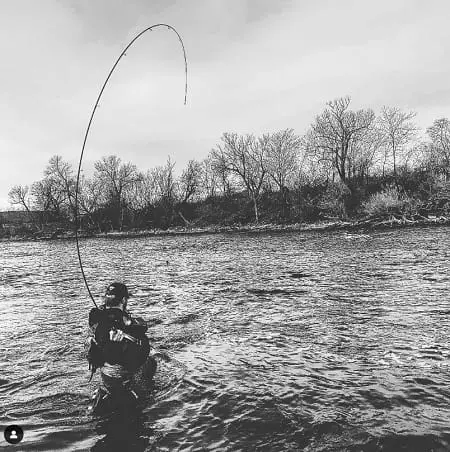
Centerpin Fishing Salmon
Float fishing is done with a spinning reel, or a baitcasting reel. However, to make float fishing even more effective, anglers use what is called a Centerpin reel, or also known as a float reel.
The Centerpin reel looks like a fly reel or a mooching reel, except that it has no drag. This allows the mainline to feed off the reel with just the pulling of the float, which is being pulled by the current.
The Centerpin reel uses mono or braided mainline and allows you to have your bait suspended from a float, but it also allows you to get very long, smooth, controlled drifts down the river.
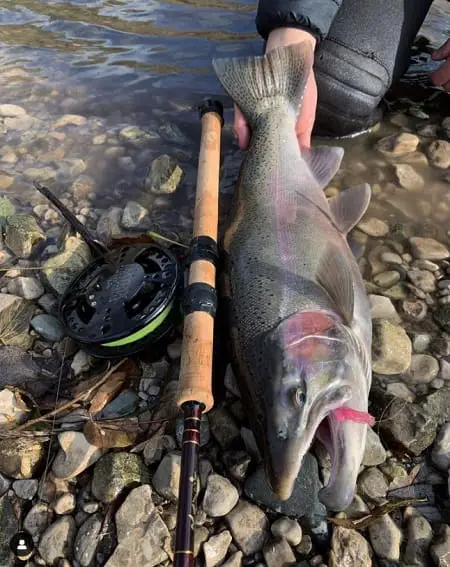
It’s these long smooth, controlled drifts, that give you a much better presentation, and that equals more fish.
In my opinion, it’s hard to beat a Centerpin reel when float fishing.
Check out Centerpin Fishing For River Salmon: Guide Tips and Tricks.
You may also be interested in 10 Best Salmon Leaders And Setups For Multiple Methods.
Drift Fishing Method For Salmon
Drift fishing is a great bank fishing method used in deeper faster water without a bobber or float.

With drift fishing, you cast out into the main current and let the line drift down the river. Your line, leader, some weights, and your bait drift downriver with a semi-tight line, and you watch the line for any twitching, pulling, or sinking of the line, indicating a bite.
Drift fishing can use all kinds of baits. For more on Salmon Drift Fishing: Everything You Need To Know
Drift fishing for some anglers can also mean drifting down the river in a boat, which is a whole other topic.
Side Drifting For Salmon
Side drifting is a method where the boat drifts down the river while the angler drifts their side drifting rigs off the side of the boat. See Side Drifting For Salmon.
Bottom Bouncing For Salmon
Bottom bouncing is similar to drift fishing, except I will use it in shallower water, or when fishing closer to me, and on smaller streams or smaller sections of water.
I also prefer this in pocket water or when the salmon are holding near structures like boulders and logs.
Check it out at Bottom Bouncing – 5 Proven Guide Tips For More Fish.
Plunking Method For Salmon
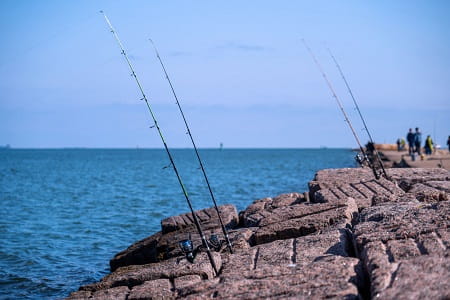
Plunking is a still fishing method where your bait or lure is close to the bottom and is anchored by a heavy weight. Plunking allows you to fish to your bait or lure in pools and slow-moving water while you wait for a hungry salmon to swim by and grab your offering.
Plunking is used in rivers and in the lake from the shore. To see more about this method, check out Plunking For Salmon: The 2 Best Setups And Baits.
Bobber Doggin For Salmon
Bobber Doggin is a relatively new method of bobber fishing when you use a bobber or float to indicate a bite as the boober drags the weights and the bait down the river.
I give you my honest thoughts on this method in my article Bobber Doggin: Trout, Steelhead, And Salmon Tactics.
Best Baits For Salmon
Some baits and sizes will work better based on the activity level of the salmon and the conditions of the river, which is why I have multiple baits on me when I fish and guide for salmon.

Some of the best baits include:
- Wooly Buggers
- Salmon egg pattern flies
- Sand shrimp or salad shrimp
- Beads and plastics
- Plastic Steelhead Worms
- Skien
- Yarn flies
Check out 10 Best Baits For River Salmon And When To Use Them.
Lure Fishing

Casting lures is a great way of catching salmon in the river or from shore. Some lures work better than others, and there are a few lure methods you can try.
Covering the water effectively with a lure, getting your lure down and deep enough, as well as working your lure properly when retrieving, it can really make a big difference.
Many colors of lures will work with silver, gold, and copper being good options. Big fall chinook salmon seem to love bright lures like chartreuse crankbaits.
Spinner Fishing

Spinners are unique in that they use both vibration and flash to attract fish.
These are generally metal lures, though some have plastic parts. They are designed to spin in the water, which creates both a vibration and usually a flash of movement.
You fish from upstream with a retrieval rate that keeps the spinner off the bottom but not near the surface.
Catching Salmon On Spoons
Spoons differ from spinners in how they move. A quality salmon spoon will wobble from side to side rather than spin, but not all spoons are created equal.

Spoons used for trolling for salmon are also known as flutter spoons, and they have a great wobble that looks like a swimming baitfish.
For casting, you need a thicker and heavier spoon that can be cast far and will stay down and below the surface in the current.
I discuss this in my article Lure Fishing For River Salmon: How The Guides Do It
Plug Fishing

Plug fishing for river salmon involves presenting plugs from the boat or casting while wading or from the bank.
The 5-inch Kwikfish K series Flo Chartreuse/Green UV is one of the best salmon lures when the salmon just enter the river.
Different types of plugs do different things. Some dive and wobble, and some just wobble.
Plugs come in a range of sizes and colors for different conditions. You can use plugs for trolling, back trolling, plunking, or you can cast and retrieve them.
Salmon anglers will occasionally cast them in rivers or at the river mouths because the slow wobble will entice big pre-spawn aggressive salmon to bite.
Jigging

Jigging can be a great way to catch salmon.
Jigging is an up-down motion where you bounce the jig off the bottom or above the bottom and then lift it up a foot or so.
The process repeats. Some salmon anglers also call this twitching jigs for salmon.
You can jig from a pier or a boat, but you want to make sure that you have enough depth so that the line remains vertical.
I discuss this method and the best jigs on my page Jigging For Salmon In Rivers: 3 Best Methods Guides Use!
Back Trolling Salmon

Back trolling is an easy and effective method where the angler moves the boat slower than the current, and the slow movement of the boat side to side and downriver drops the lure or a bait back and into the salmon zone. See Back Trolling For Salmon.
Back Bouncing Salmon
Back bouncing is when you position the boat upriver, and while holding the boat in position, you drop the bait off the back of the boat and let it and a large heavy weight drop to the bottom.
Every few seconds, the angler will lift the rod tip and pop the weight off the bottom, which moves jumps the bait downriver further, and they repeat this until the bait is down into the salmon’s zone. See Back Bouncing For Salmon.
Anchor Fishing
With anchor fishing, you are anchored, fishing from the center of the river, and the lures are out of the back of the boat and held at a height of 2 to 5 feet over the bottom.
The process allows you to take full advantage of one spot on the river when salmon will travel through and hopefully see your bait.
Anchor fishing can be dangerous on swift currents, so be sure you know how to do this well. Be sure you do it correctly and safely, watch this video on Anchor Fishing.
Check out these articles:
The Best Mainline For Fishing Salmon In Rivers
Spin Fishing Salmon: 5 Most Effective Methods and Baits
Advanced Bead Fishing Salmon: Guide Tactics and Setup
Tight Lines,
Graham

